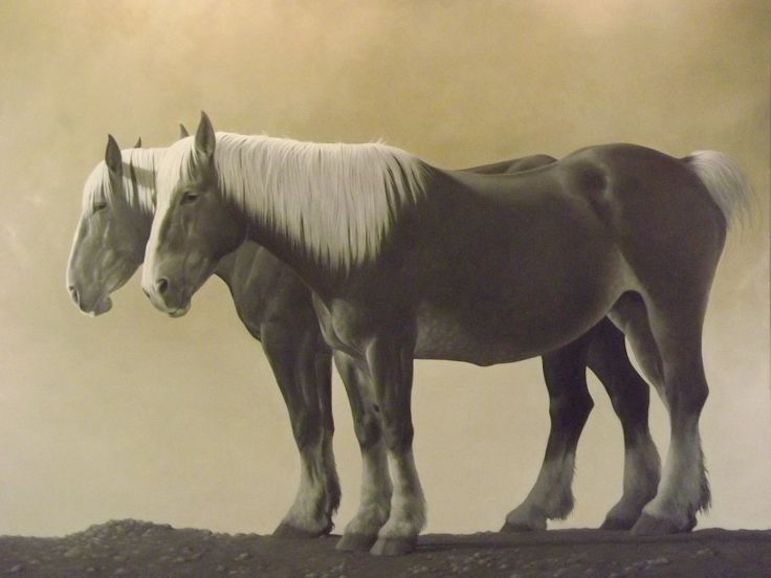Kevin Rose, who manages the Western Art Forum gallery in downtown Billings, says Jerry Cornelia will be the featured artist during the Feb. 3 Winter ArtWalk for two reasons.
One is that gallery owner and painter Kira Fercho is a big fan of the Sidney artist.
“He’s like a superstar,” Rose said. “Kira calls him her first art crush, when she was 16 years old.”
The other reason is that Cornelia has stopped producing his bright, whimsical, slightly cracked and always quite funny paintings, the ones with wry titles and often featuring sheep, dogs and women with startlingly red hair.
“He’s a hoot,” Rose said. “He’s just so frickin’ funny.”

Jerry Cornelia
Most of Cornelia’s works in that vein—he figures he painted a couple hundred of them—have long since been sold. The show at the Western Art Forum will bring together about a dozen of those still on the market.
They include a painting of a forlorn hairless sheep wearing four high-heeled boots. It is titled, “Well, thought Hector, I did tell her I would do anything for her.” Another shows just the torso and head of a rather stolid-looking sheep, titled, “You could call Harold a lot of things, but at least you couldn’t call him a Republican.”
Cornelia, reached by phone at his house about a mile outside of Sidney, said he was doing serious work, mostly abstract expressionism and surrealism, with some ventures into realistic sculpture, when he tapped into a vein of humor he wasn’t really aware of.
He did the first one as a throwaway, a bit of relief from his “real” work. This would have been in about 2001, after suffering a pair of heart attacks and then a fire at his house and studio, which destroyed many paintings and sculptures and numerous tools.
He painted a picture of a dejected sheep standing under a lone apple tree, with a lemon on the ground. The title: “It had not been the best of years for Clifford.”
He liked it so much and had so much fun painting it that he did a few more, and before he knew it they were popular, selling particularly well at galleries in Bozeman and Livingston.
His method was to think up the titles first, then produce the appropriate painting. He was always jotting down ideas, even when he was driving.
“It was sort of before texting,” he said. “It was my bad driving time.” He said he’s still surprised that he wasn’t found dead in a car wreck, a pencil stuck in his head. Then, two or three years ago, he stopped doing the whimsical pieces.“It was almost like I ran out of—I don’t like to call them jokes, but they’re almost jokes,” he said. “I didn’t want to force them. If I start getting a sense of humor I might do them again.”
Cornelia laughed after saying that, and in fact for a man who claims to have lost his sense of humor he laughs quite a bit. But he is 62 years old, and a couple of years ago, he said, “I think mortality was setting in or something, and I decided I needed to do museum-quality stuff.”
He is a self-taught artist and he wanted “to put everything I’d learned over 50 years into these new pieces.” Most of them are paintings of horses, done in a detailed, meticulously rendered realism that doesn’t look much like “Western” art. Cornelia said it has more to do with academic figure drawing, with attention to shapes and abstractions and the relationship of the subjects to the negative spaces around them.

“You think I’m a bitch, you should see my sister.”
Rose, who is also a painter, drew a visitor’s attention to the one horse painting of Cornelia’s that will also be on display at the next ArtWalk, a large, mostly gray painting of two horses, titled “Golden Girls.” It’s not just realistic, Rose said with some awe, leaning in close to the canvas, it’s technically amazing. You can’t even see the brush strokes, he said, no matter how closely you look.
Cornelia, who was born on a farm near Sidney and moved into town with his family when he was an infant, was always interested in art. He made countless clay dinosaurs as a young boy, and in school he became obsessed with sketching women’s eyes, just one eye at a time, and often on his class papers, which his teachers did not appreciate.
After high school, he studied fashion design in Atlanta, then moved to New York City in 1985 to become an artist. He soon realized that he’d better start earning a living in the meantime, and he saw this help-wanted ad in the Village Voice: “Paint mannequin faces.”
He didn’t even realize the faces were individually painted, but once he found out what the job entailed, he thought back to all those eyes he’d drawn and he said to himself, “Oh, my god. I’ve been training for this job since the first grade.”
Over several years, he said, he painted something like 17,000 mannequins, each one according to the specifications of the buyer. And they were anything but uniform productions. One client kissed a business card and said she wanted the mannequins to have precisely that shade of lipstick.

“Although Coco’s past was sometimes a blur, her future was always bright.”
One client flew him to Hawaii, where he spent nine days painting mannequins. He said it was cheaper to fly him to Hawaii than to paint the mannequins in New York and fly them to Hawaii. He also worked on window displays, at Saks Fifth Avenue and a few other stores, and he was doing well.
All it took, though, was one key marketer to make the switch to the big photo banners one sees at so many stores these days. The mannequin business tanked and Cornelia was laid off.
He tried his hand at a few other things, including expensive, hand-painted birdhouses. He sold some of those and other works, but he missed the mannequins. “It was a dream job that I didn’t even know existed until I saw that ad,” he said.
So when his father’s health started declining, it seemed like an easy decision to move back to Sidney in 1995. He’s been there ever since, painting and sculpting and, increasingly, keeping to himself.
He had been getting out less and less, and then came the Bakken oil boom, which filled the local bars with people whose idea of a good time was picking fights.
“It’s turned me into a hermit, which was happening anyway,” Cornelia said. “That’s the nice thing about being an artist. You can stay home if you want to.”
That’s why he won’t be at the Western Art Forum for the show on Feb. 3. But he may end up in Billings one of these days for good. After the Bakken boom sent housing prices soaring in Sidney, he said, he briefly considered buying a place in Las Vegas, where there was a real-estate bust.
He’s glad he didn’t—hard to imagine living in Vegas long-term—but now housing prices in Billings are looking pretty good.
The change might do him good. Who knows, it could even restore his sense of humor.







